第五章 克隆基因的表达分析
分子生物学-11-1-第五章基因克隆技术
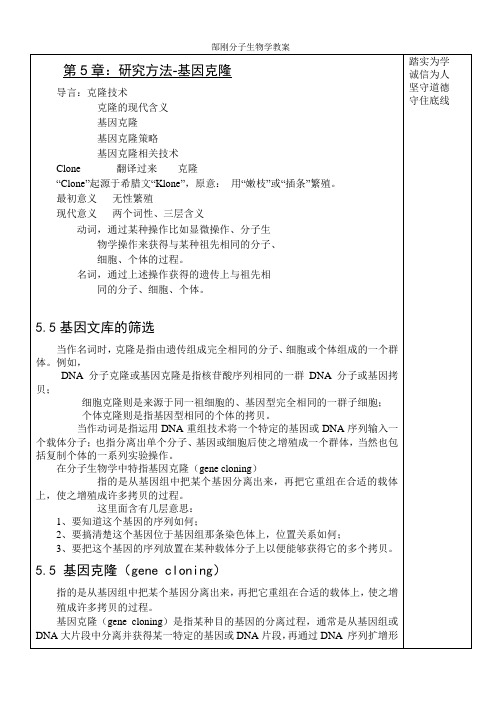
当作动词是指运用DNA重组技术将一个特定的基因或DNA序列输入一个载体分子;也指分离出单个分子、基因或细胞后使之增殖成一个群体,当然也包括复制个体的一系列实验操作。
在分子生物学中特指基因克隆(gene cloning)
指的是从基因组中把某个基因分离出来,再把它重组在合适的载体上,使之增殖成许多拷贝的过程。
但是已知的基因与未知基因存在连锁关系的并不多,所以连锁分析对克隆大多数基因存在着一定的困难。
RFLP等分子标记的出现使多态性基因标记存在于整个基因组内,解决了连锁分析中难以克服的困难。
寻找连锁基因就转变成了寻找连锁标记。
2、要有合适的与目的基因紧密连锁的分子标记做筛库的从一个相同的cDNA模板进行5‘和3‘末端快速克隆的方法。
首要条件:
至少获得mRNA的23-28个核苷酸序列信息,以此来设计5’末端和3‘末端RACE反应的基因特异性引物(gene specific primer,GSP)
克隆目标cDNA全长3种情况,3种策略
已知序列的来源
对已知序列的基因克隆是基因克隆方法中最为简便的一种。获取基因序列多从文献中查取,即将别人报道的基因序列直接作为自己克隆的依据。现在国际上公开发行的杂志一般都不登载整个基因序列,而要求作者在投稿之前将文章中所涉及的基因序列在基因库中注册,拟发表的文章中仅提供该基因在基因库中的注册号(accession number),以便别人参考和查询。
异常功能蛋白质
根据氨基酸序列推导DN的编码基因
产物序列未知基因的功能克隆方法
(适用于功能已知、产物未知的基因)
mRNA差异展示(mRNA differential display,DDRT-PCR)
克隆基因的表达
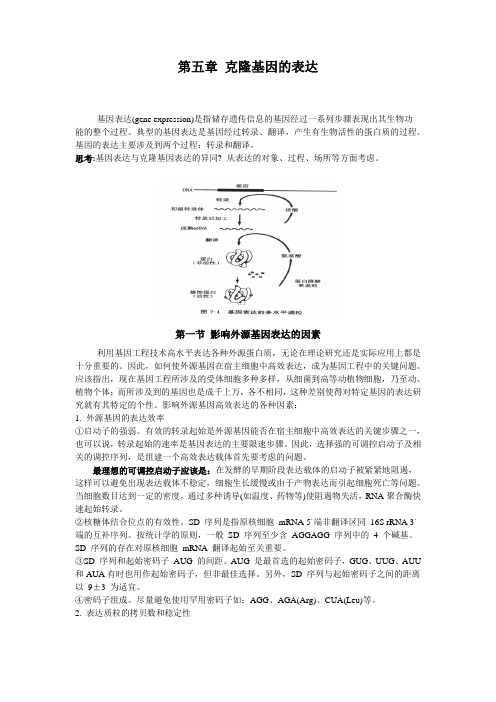
第五章克隆基因的表达基因表达(gene expression)是指储存遗传信息的基因经过一系列步骤表现出其生物功能的整个过程。
典型的基因表达是基因经过转录、翻译,产生有生物活性的蛋白质的过程。
基因的表达主要涉及到两个过程:转录和翻译。
思考:基因表达与克隆基因表达的异同? 从表达的对象、过程、场所等方面考虑。
第一节影响外源基因表达的因素利用基因工程技术高水平表达各种外源蛋白质,无论在理论研究还是实际应用上都是十分重要的。
因此,如何使外源基因在宿主细胞中高效表达,成为基因工程中的关键问题。
应该指出,现在基因工程所涉及的受体细胞多种多样,从细菌到高等动植物细胞,乃至动、植物个体;而所涉及到的基因也是成千上万,各不相同,这种差别使得对特定基因的表达研究就有其特定的个性。
影响外源基因高效表达的各种因素:1. 外源基因的表达效率①启动子的强弱。
有效的转录起始是外源基因能否在宿主细胞中高效表达的关键步骤之一,也可以说,转录起始的速率是基因表达的主要限速步骤。
因此,选择强的可调控启动子及相关的调控序列,是组建一个高效表达载体首先要考虑的问题。
最理想的可调控启动子应该是:在发酵的早期阶段表达载体的启动子被紧紧地阻遏,这样可以避免出现表达载体不稳定,细胞生长缓慢或由于产物表达而引起细胞死亡等问题。
当细胞数目达到一定的密度,通过多种诱导(如温度、药物等)使阻遏物失活,RNA聚合酶快速起始转录。
②核糖体结合位点的有效性。
SD 序列是指原核细胞mRNA 5`端非翻译区同16S rRNA 3` 端的互补序列。
按统计学的原则,一般SD 序列至少含AGGAGG 序列中的4 个碱基。
SD 序列的存在对原核细胞mRNA 翻译起始至关重要。
③SD 序列和起始密码子AUG 的间距。
AUG 是最首选的起始密码子,GUG、UUG、AUU 和AUA有时也用作起始密码子,但非最佳选择。
另外,SD 序列与起始密码子之间的距离以9±3 为适宜。
基因工程中的基因克隆与基因表达实验总结
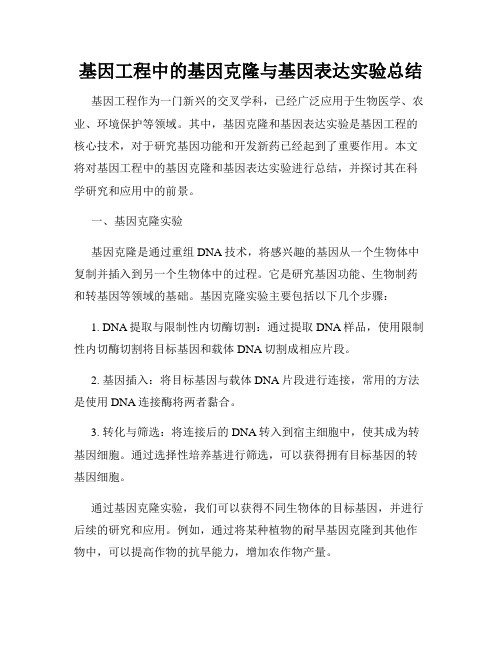
基因工程中的基因克隆与基因表达实验总结基因工程作为一门新兴的交叉学科,已经广泛应用于生物医学、农业、环境保护等领域。
其中,基因克隆和基因表达实验是基因工程的核心技术,对于研究基因功能和开发新药已经起到了重要作用。
本文将对基因工程中的基因克隆和基因表达实验进行总结,并探讨其在科学研究和应用中的前景。
一、基因克隆实验基因克隆是通过重组DNA技术,将感兴趣的基因从一个生物体中复制并插入到另一个生物体中的过程。
它是研究基因功能、生物制药和转基因等领域的基础。
基因克隆实验主要包括以下几个步骤:1. DNA提取与限制性内切酶切割:通过提取DNA样品,使用限制性内切酶切割将目标基因和载体DNA切割成相应片段。
2. 基因插入:将目标基因与载体DNA片段进行连接,常用的方法是使用DNA连接酶将两者黏合。
3. 转化与筛选:将连接后的DNA转入到宿主细胞中,使其成为转基因细胞。
通过选择性培养基进行筛选,可以获得拥有目标基因的转基因细胞。
通过基因克隆实验,我们可以获得不同生物体的目标基因,并进行后续的研究和应用。
例如,通过将某种植物的耐旱基因克隆到其他作物中,可以提高作物的抗旱能力,增加农作物产量。
二、基因表达实验基因表达实验是将目标基因在宿主细胞中进行转录和翻译,产生具有特定功能的蛋白质的过程。
基因表达实验是研究基因功能和制备重组蛋白等领域的重要手段。
基因表达实验主要包括以下几个步骤:1. 选择合适的表达系统:根据需要表达的蛋白质的性质和规模,选择合适的表达系统。
常用的表达系统包括细菌、酵母、哺乳动物细胞等。
2. 构建表达载体:将目标基因插入到表达载体中,通常使用限制性内切酶和DNA连接酶进行连接,并通过测序确保插入正确。
3. 细胞转染:将构建好的表达载体导入到宿主细胞中。
不同表达系统有不同的转染方法,如细菌的化学转型、酵母的电转染等。
4. 表达和纯化:经过一定时间的培养,宿主细胞会表达目标基因,合成目标蛋白质。
可以通过蛋白质纯化技术,如亲和层析、凝胶电泳等手段获得纯度较高的目标蛋白质。
基因克隆与表达
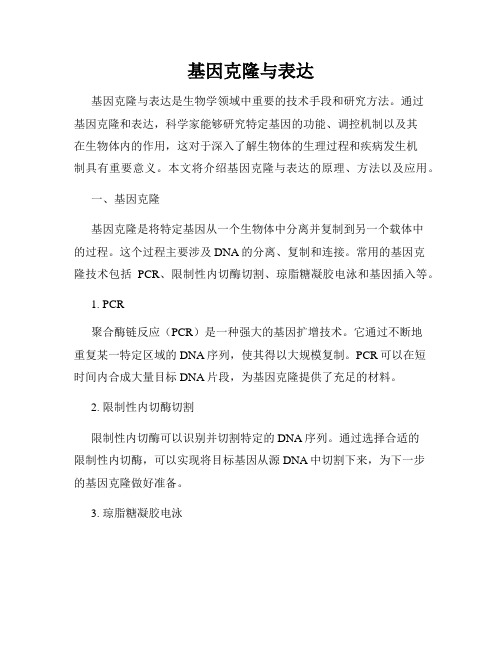
基因克隆与表达基因克隆与表达是生物学领域中重要的技术手段和研究方法。
通过基因克隆和表达,科学家能够研究特定基因的功能、调控机制以及其在生物体内的作用,这对于深入了解生物体的生理过程和疾病发生机制具有重要意义。
本文将介绍基因克隆与表达的原理、方法以及应用。
一、基因克隆基因克隆是将特定基因从一个生物体中分离并复制到另一个载体中的过程。
这个过程主要涉及DNA的分离、复制和连接。
常用的基因克隆技术包括PCR、限制性内切酶切割、琼脂糖凝胶电泳和基因插入等。
1. PCR聚合酶链反应(PCR)是一种强大的基因扩增技术。
它通过不断地重复某一特定区域的DNA序列,使其得以大规模复制。
PCR可以在短时间内合成大量目标DNA片段,为基因克隆提供了充足的材料。
2. 限制性内切酶切割限制性内切酶可以识别并切割特定的DNA序列。
通过选择合适的限制性内切酶,可以实现将目标基因从源DNA中切割下来,为下一步的基因克隆做好准备。
3. 琼脂糖凝胶电泳琼脂糖凝胶电泳是一种常用的DNA分离技术。
通过将DNA样品加入琼脂糖凝胶槽中,并施加电场,DNA片段会根据其大小在凝胶中迁移。
凝胶电泳可以帮助科学家分离和纯化目标基因。
4. 基因插入基因插入是将目标基因连接到载体上的过程。
载体可以是质粒、病毒或者人工染色体等。
通过连接酶的作用,目标基因与载体可以稳定地结合在一起。
二、基因表达基因表达指特定基因通过转录和翻译过程转化为蛋白质的过程。
从基因克隆到基因表达,可以分为以下几个步骤:转染或转化、筛选和检测。
1. 转染或转化转染是指将外源DNA导入到动物细胞中的过程,而转化是将外源DNA导入到细菌细胞中的过程。
转染和转化可以通过多种方法实现,如化学法、电穿孔法和基因枪法等。
2. 筛选筛选是为了确定是否成功将目标基因表达在宿主细胞中而进行的步骤。
常见的筛选方法包括荧光筛选和克隆筛选。
荧光筛选利用荧光蛋白标记目标基因,观察细胞是否出现荧光信号。
克隆筛选则利用选择性培养基,筛选出含有目标基因的克隆。
第五章 克隆基因的表达_PPT幻灯片
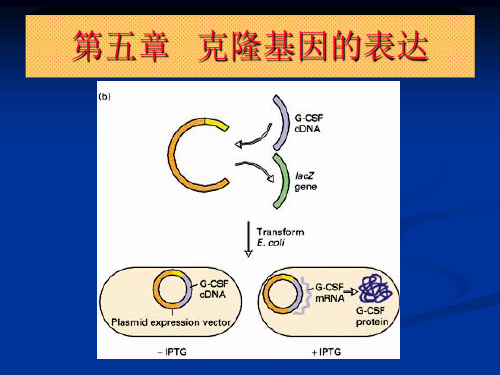
识别原核细胞的启动子,催化所有的 RNA合成。 2. 以操纵子为单位
数个相关的结构基因与其调控区结合形 成一个表达的协同单位。
3. 转录和翻译偶联、连续进行。
Hale Waihona Puke 5’有意义链3’
3’
反意义链
5’
转录
5’
mRNA
3’
翻译
N
蛋白质
C
4. 不含内含子,缺乏转录后的加工系统。 5. 调控主要在转录水平上。 6. mRNA的核糖体结合位点
5-CCCACAGCCGCCAGTTCCGCTGGCGGCATTTTAA CT TCT TTCT-3 3-GGGTGTCGGCGGTCAAGGCGACCGCCGTAAAATTGAAGAAAGA-5(模板)
转录↓
5-CCCACAGCCGCCAGUUCCGCUGGCGGCAUUUU-OH-3(RNA)
组成: 阻遏物作用区 CAP作用区 RNA聚合酶作用区
长度:
203bp的HaeIII片断 (包括β-半乳糖苷酶的前8个密码)。
IPTG =异丙基硫 代-β-D半乳糖
IPTG有毒、昂 贵,不理想。
(3)色氨酸启动子trp 来自大肠杆菌的色氨酸操纵子。
trpR P1 O trpE trpD P2 trpC trpB trpA
5. 防止外源基因产物对宿主细胞的毒害。
三、原核生物基因表达的调控
1. 启动子 是DNA上的能与RNA聚合酶结合并能起始 mRNA合成的序列。 (1) 启动子序列
大肠杆菌的所有启动子中都有两段一致 顺序(consensus sequence)。
-35 Box 和 -10 Box
consensus sequences
克隆基因的表达
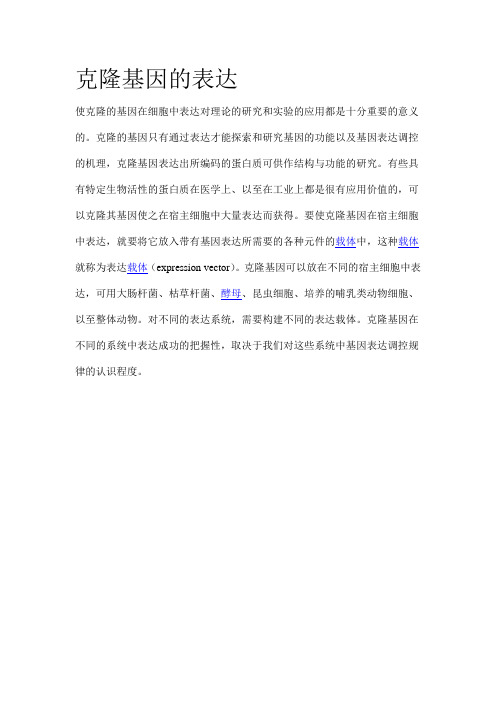
克隆基因的表达使克隆的基因在细胞中表达对理论的研究和实验的应用都是十分重要的意义的。
克隆的基因只有通过表达才能探索和研究基因的功能以及基因表达调控的机理,克隆基因表达出所编码的蛋白质可供作结构与功能的研究。
有些具有特定生物活性的蛋白质在医学上、以至在工业上都是很有应用价值的,可以克隆其基因使之在宿主细胞中大量表达而获得。
要使克隆基因在宿主细胞中表达,就要将它放入带有基因表达所需要的各种元件的载体中,这种载体就称为表达载体(expression vector)。
克隆基因可以放在不同的宿主细胞中表达,可用大肠杆菌、枯草杆菌、酵母、昆虫细胞、培养的哺乳类动物细胞、以至整体动物。
对不同的表达系统,需要构建不同的表达载体。
克隆基因在不同的系统中表达成功的把握性,取决于我们对这些系统中基因表达调控规律的认识程度。
图1几种常用的大肠杆菌表达载体人类对大肠杆菌经过长期的研究,对其特性和遗传背景了解得最清楚,大肠杆菌培养操作简单、生长繁殖快、价格低廉,人们用大肠杆菌用外源基因的表达工具已有二十多年的经验积累,大肠杆菌表达外源基因产物的水平远高于其它基因表达系统,表达的目的蛋白量甚至能超过细菌总蛋白量的80%。
因此大肠杆菌是目前应用最广泛的蛋白质表达系统。
设计外源基因在大肠杆菌表达就需要外源基因在大肠杆菌中表达所需要的元件,包括转录起始必需的启动子、翻译起始所必需的核糖体识别序列等;外源基因表达的产物可能会对大肠杆菌有毒害作用,会影响细菌的生存繁殖,所以大多数表达载体都带有诱导性表达所需要的元件,即有操纵子序列以及与之配套的调控基因等;外源基因还应当插入到适合于表达的位置,所以表达载体中要设有适合的多克隆位点;此外还应具备基因克隆筛选的条件,包括在细胞中复制必需的复制起始序列、筛选标志如抗药性基因等。
图2中绘出几种常用的表达载体例子。
pBV220是我国科学工用者自己构建的表达载体,使用了很强的PRPL双启动子,含有编码温度敏感性阻遏蛋白的cI857基因,在30-32℃时产生的阻遏蛋白能阻止PRPL的转录起始,细菌可以正常生长繁殖,42摄氏度时该阻遏蛋白发生构像变化而失活,基因开始转录而表达。
克隆基因表达--原核表达ppt课件

活性高和表达产物容易分离纯化。这
就要求选择合适的宿主细胞,合适的
表达载体和适当的纯化方案。
4
宿主细胞应满足以下要求:
容易获得较高浓度的细胞且利用易得廉价原料 不致病、不产生内毒素 发热量低、需氧低、适当的发酵温度和细胞形态 容易进行DNA重组技术操作和代谢调控 产物的产量、产率高且易于提取纯化
8
大肠杆菌表达体系的特点
• 经过长期的研究,已经掌握了有关大肠杆菌基础生物学、 遗传学以及分子生物学等方面的背景知识,特别是对基 因表达调控的分子机理; • 被发展成为安全的基因工程实验体系,拥有各类适用的 寄主菌株和不同类型的载体系列;
• 许多克隆的真核基因,如生长素和胰岛素基因等已实现 有效的、高水平的表达; • 大肠杆菌培养方便、操作简单、成本低廉,因此易于进 行工业化批量生产。
9
(一)对外源目的基因的要求
真核基因含有的内含 子,可在基因转录过 真核启动子缺乏结合 程被RNA酶催体系剪 细菌核糖体所必须的 真核基因 mRNA分子 辑删除掉 SD 序列;细菌的 的 5’端帽子和 3’端尾 细菌缺乏对真核基 RNA 聚合酶不能识别 巴结构影响其在原核 (1)利用大肠杆菌表达真核基因存在问题 因的蛋白产物正确 真核启动子 中的稳定性和与核糖 折叠和组装过程, 结构上存在很大的区别 体结合的能力 表达产物要经过复 转译起始信号不同 性异源性蛋 白 mRNA分子结构的不同 原核生物缺乏转译后的修饰过程
细菌的蛋白酶能识别目的蛋白并将其降解
10
(一)对外源目的基因的要求
(2) 外源目的基因的基本要求
不含有内含子结构(cDNA或是mRNA) 不具有5´端非编码区
11
(二)原核生物表达载体
基因克隆及克隆基因的表达

LOGO
三、目的DNA与载体连接(接)
T4DNA ligase
LOGO
四、重组DNA转入宿主细胞进行扩增(转)
宿主细胞
感受态细胞(competent cell):
处于易于接纳外源物质的状态的细菌
LOGO
几个相关概念:
Lac I
Prokaryotic Expression Plasmid
LOGO
一、原核宿主细胞 大肠杆菌(E.coli)
优点:简便, 快速、成本低 可高密度发酵培养 20-30min
注意:
12 hours Once 用来克隆基因和表达基因的菌株不一样, the recombinant system is established, it is cheap to manufacture.
T-载体:
T7
pMD18-T 2692bp
HindIII Spln PstI HincII AccI SalI
T
T
Xbal BamHI SmaI XmaI KpnI SacI EcoRI
LOGO Sp6
克隆载体用于外源DNA的克隆和无性繁殖
(二)常用克隆载体的种类
速高效表达基因产物。
真核表达系统: 外源基因引入真核细胞,使外源
基因在真核细胞中表达。
LOGO
第一部分.外源基因在原核细胞中的表达
原核细胞表达 系统组成
一、原核宿主细胞 二、原核表达载体
Recombinant Protein
wΒιβλιοθήκη
转化(transformation) 质粒或黏粒→细菌 质粒→酵母(真核细胞) 转染(transfection) 外源DNA→真核细胞(酵母除外) 感染(infection) 噬菌体颗粒→细菌 病毒颗粒→哺乳细胞
基因工程中的基因克隆与表达
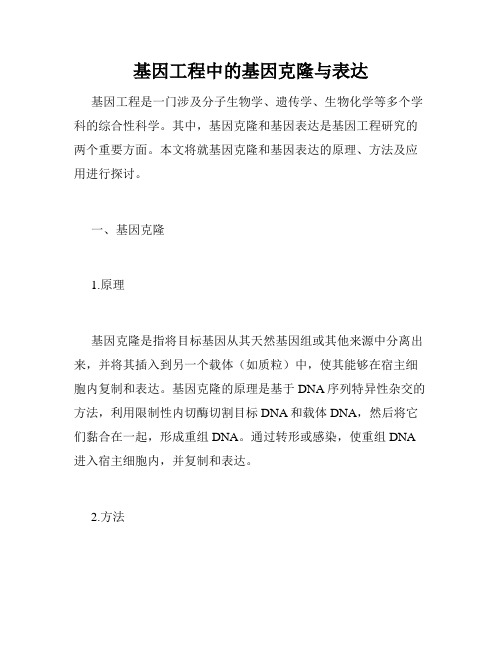
基因工程中的基因克隆与表达基因工程是一门涉及分子生物学、遗传学、生物化学等多个学科的综合性科学。
其中,基因克隆和基因表达是基因工程研究的两个重要方面。
本文将就基因克隆和基因表达的原理、方法及应用进行探讨。
一、基因克隆1.原理基因克隆是指将目标基因从其天然基因组或其他来源中分离出来,并将其插入到另一个载体(如质粒)中,使其能够在宿主细胞内复制和表达。
基因克隆的原理是基于DNA序列特异性杂交的方法,利用限制性内切酶切割目标DNA和载体DNA,然后将它们黏合在一起,形成重组DNA。
通过转形或感染,使重组DNA 进入宿主细胞内,并复制和表达。
2.方法基因克隆的方法主要有限制性酶切与黏合(RE-Mediated Ligation)、PCR(聚合酶链反应)、TA克隆和基因文库等。
限制性酶切与黏合是一种常用的基因克隆方法。
该方法利用限制性内切酶切割DNA,然后通过T4 DNA连接酶黏合在一起。
这种方法操作简单、效率高,但存在限制内切酶的局限性,无法应用于不同酶切位点的DNA。
PCR是用于复制DNA片段的重要方法,也可以用于基因克隆。
PCR方法可以在不使用限制酶的情况下,从任何源提取DNA片段,扩增需要的基因段,并使用酶切和连接技术插入到载体中。
TA克隆是指用于从PCR产物中克隆DNA的一种方法。
该方法利用了Taq聚合酶不完全特异性合成3'-末端斜伸的性质,使产生的末端序列与T自带的A进行互补配对,从而使PCR产物能够被直接连接到TA克隆载体上。
基因文库是一种重要的基因克隆技术,可以将许多目标基因同时克隆入同一载体中。
基因文库分为cDNA文库和基因组文库。
通过荧光筛选或选择性培养,可以从文库中筛选出感兴趣的基因。
3.应用基因克隆技术广泛应用于基因工程、疫苗制备、药物研发、作物改良、动物遗传改良、环境污染治理等领域。
例如,利用基因克隆技术可以创造出超级细菌、工业用酶、新型药物、高产优质作物等。
二、基因表达1.原理基因表达是指基因通过转录和翻译的过程,将DNA序列转化为蛋白质的过程。
基因的克隆与表达-2005
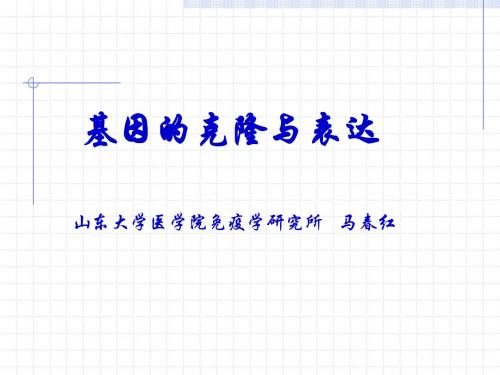
构型:
超螺旋型(supercoiled circle,SC) or 共价闭环双股DNA( covalently closed circle,CCC) 开环型(opened circle,OC) 线形(linear circle,LC)
3、载体组成
物理图谱(phisical map)
4、载体主要元件(特点) 及其应用
(四)常见人工构建质粒的分类:
人工构建的质粒根据其功能及用途分为: 1.多拷贝质粒 复制子经过人工突变,除去控制拷贝数 负调节基因,使质粒拷贝数达到每个细胞数千,用于 扩增外源基因。 2.测序质粒 3.整合质粒 装有整合促进基因及整合特异序列,便于 外源基因准确重组整合入受体细胞的染色体上 4.穿梭质粒 含有两个不同的复制子,能在两种不同的 受体细胞中复制 5.表达质粒 装有强的启动基因,合适的顺序以及有效 的终止子,以便任何外源基因在受体细胞内的高效表 达
两种解决方案:
1)缩短长度:λ-DNA上约有40-50%的DNA片段是 复制,裂解所不必需的,将之切除便可提高载量。 2)修饰酶切识别位点:利用自然选择法获得限制 性位点缺失的λ品系。 天然的λ-DNA上有多个酶切位点,如:EcoRI 5个, HindIII 7个,这些多余的酶切位点必须被修饰。
自然选择法:利用一 个产生EcoRI的大肠杆菌, 大部分侵入细胞的λ DNA分子会被限制性酶破 坏,少部分能够成活, 这些就是突变型的噬菌 体,其EcoRI位点缺失了。
(三) λ噬菌体载体
1、基本组成元件
• Cos位点 • 左臂(头尾基因) • 右臂(裂解基因) • 酶切位点
分子生物学 基因克隆及克隆基因的表达

Bam HⅠ GGATCC CCTAGG
Bg lⅡ AGATCT TCTAGA
互连后?
GCCTAG+
GATCC G
A
+GATCT
TCTAG
ALOGO
Ⅱ型限制性内切酶具有一些共性和特性:
5. 不同的酶可以识别同一个序列 同工异源酶(isoschizomer)或同裂酶 能识别同一序列(切割位点可同或不同)但来源不同的两种酶。
LOGO
聚合酶链式反应
Polymerase Chain Reaction, PCR
体外高效特异性的扩增目的DNA片段
LOGO
LOGO
LOGO
LOGO
LOGO
PCR的基本原理
• PCR反应条件 • PCR过程 • PCR的特点
1
2
3
高温变性 低温退火 适温延伸
94
温
度 72
(℃)
55
22
DNA 2
3’
3’
5’
上游引物、5’ 引物、Sense primer
PCR反应扩增的就是一对引物之间的DNA片段,PCR反应 成功扩增的关键在于引物的正确设计。
引物设计的总原则——提高引物与模板结合的特异性。
LOGO
PCR引物设计的基本原则: 1.引物与模板的序列要紧密互补。 2.引物自身、引物之间不应存在互补序列。 3.引物不能在模板的非目的位点引发PCR。
LOGO
分子生物学关键的技术突破: DNA重组技术
1972年, 世界上第一个重组DNA分子诞生
1980年, 获诺贝尔化学奖
猿猴病毒DNA
噬菌体DNA
限制性内切酶
限制性内切酶
DNA连接酶 重组DNA分子
克隆基因表达--真核表达

39
重组DNA医药产品(目前上市的有300多种) 医药产品(目前上市的有 多种) 重组 医药产品 多种
产 品 组织胞浆素原激活剂 血液因子VIII 血液因子 颗粒细胞-巨噬细胞集落剌激因子 颗粒细胞 巨噬细胞集落剌激因子 促红细胞生成素 生长因子(bFGF, EGF) 生长因子 生长素 胰岛素 干扰素(α 干扰素 α 1b, α2a, α 2b, γ) 白细胞介素2 白细胞介素 超氧化物歧化酶 单克隆抗体 乙肝疫苗 口服重组B亚单位菌体霍乱菌苗 口服重组 亚单位菌体霍乱菌苗 功 能 抗凝(哺乳动物) 抗凝(哺乳动物) 促进凝血(哺乳动物) 促进凝血(哺乳动物) 剌激白细胞生成 剌激白细胞生成(哺乳动物) 剌激白细胞生成(哺乳动物) 刺激细胞生长与分化(哺乳动物) 刺激细胞生长与分化(哺乳动物) 治疗侏儒症(大肠杆菌) 治疗侏儒症(大肠杆菌) 治疗糖尿病(大肠杆菌) 治疗糖尿病(大肠杆菌) 抗病毒感染及某些肿瘤(大肠杆菌) 抗病毒感染及某些肿瘤(大肠杆菌) 激活、剌激各类白细胞(哺乳动物) 激活、剌激各类白细胞(哺乳动物) 抗组织损伤 利用其结合特异性进行诊断试验、 利用其结合特异性进行诊断试验、肿瘤 导向治疗(哺乳动物) 导向治疗(哺乳动物) 预防乙肝(CHO, 酵母) 预防乙肝 酵母 预防霍乱
其中酿酒酵母的遗传学和分子生物学研究最为详尽, 其中酿酒酵母的遗传学和分子生物学研究最为详尽, 酿酒酵母的遗传学和分子生物学研究最为详尽 但巴斯德毕赤酵母(甲醇酵母)表达外源基因最理想。 巴斯德毕赤酵母(甲醇酵母)表达外源基因最理想。
10
2、酵母表达载体(一般为穿梭质粒) 酵母表达载体(一般为穿梭质粒) 穿梭质粒
2µm环:是酿酒酵母中天然存在的内源性质粒 环 DNA,长度为 ,长度为2µm,一般存在于核质中,每个细 ,一般存在于核质中, 胞平均有50- 个拷贝数, 胞平均有 -100个拷贝数,可以独立复制并转 个拷贝数 录。
克隆基因的表达
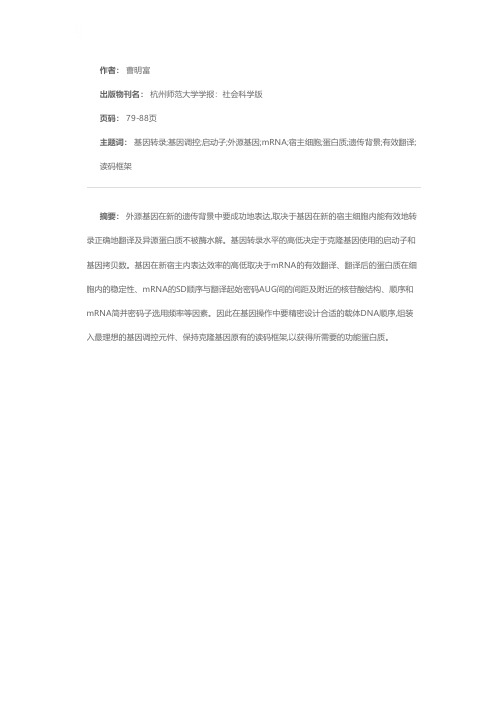
作者: 曹明富
出版物刊名: 杭州师范大学学报:社会科学版
页码: 79-88页
主题词: 基因转录;基因调控;启动子;外源基因;mRNA;宿主细胞;蛋白质;遗传背景;有效翻译;
读码框架
摘要: 外源基因在新的遗传背景中要成功地表达,取决于基因在新的宿主细胞内能有效地转录正确地翻译及异源蛋白质不被酶水解。
基因转录水平的高低决定于克隆基因使用的启动子和基因拷贝数。
基因在新宿主内表达效率的高低取决于mRNA的有效翻译、翻译后的蛋白质在细胞内的稳定性、mRNA的SD顺序与翻译起始密码AUG间的间距及附近的核苷酸结构、顺序和mRNA简并密码子选用频率等因素。
因此在基因操作中要精密设计合适的载体DNA顺序,组装入最理想的基因调控元件、保持克隆基因原有的读码框架,以获得所需要的功能蛋白质。
克隆基因的高效表达
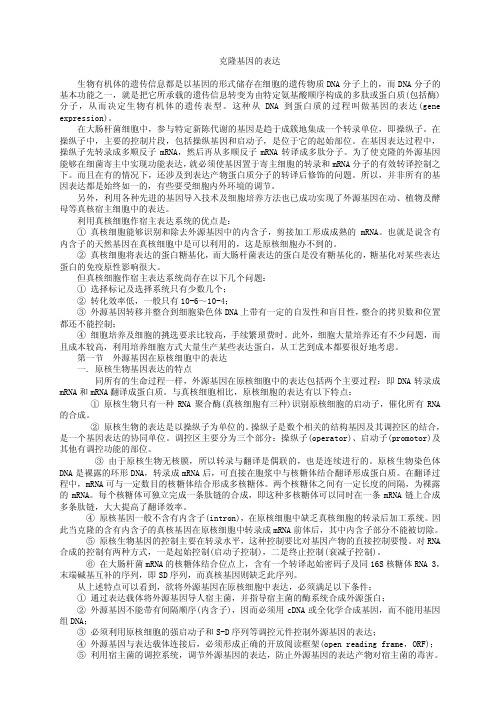
克隆基因的表达生物有机体的遗传信息都是以基因的形式储存在细胞的遗传物质DNA分子上的,而DNA分子的基本功能之一,就是把它所承载的遗传信息转变为由特定氨基酸顺序构成的多肽或蛋白质(包括酶)分子,从而决定生物有机体的遗传表型。
这种从DNA到蛋白质的过程叫做基因的表达(gene expression)。
在大肠杆菌细胞中,参与特定新陈代谢的基因是趋于成簇地集成一个转录单位,即操纵子。
在操纵子中,主要的控制片段,包括操纵基因和启动子,是位于它的起始部位。
在基因表达过程中,操纵子先转录成多顺反子mRNA,然后再从多顺反子mRNA转译成多肽分子。
为了使克隆的外源基因能够在细菌寄主中实现功能表达,就必须使基因置于寄主细胞的转录和mRNA分子的有效转译控制之下。
而且在有的情况下,还涉及到表达产物蛋白质分子的转译后修饰的问题。
所以,并非所有的基因表达都是始终如一的,有些要受细胞内外环境的调节。
另外,利用各种先进的基因导入技术及细胞培养方法也已成功实现了外源基因在动、植物及酵母等真核宿主细胞中的表达。
利用真核细胞作宿主表达系统的优点是:① 真核细胞能够识别和除去外源基因中的内含子,剪接加工形成成熟的mRNA。
也就是说含有内含子的天然基因在真核细胞中是可以利用的,这是原核细胞办不到的。
② 真核细胞将表达的蛋白糖基化,而大肠杆菌表达的蛋白是没有糖基化的,糖基化对某些表达蛋白的免疫原性影响很大。
但真核细胞作宿主表达系统尚存在以下几个问题:① 选择标记及选择系统只有少数几个;② 转化效率低,一般只有10-6~10-4;③ 外源基因转移并整合到细胞染色体DNA上带有一定的自发性和盲目性,整合的拷贝数和位置都还不能控制;④ 细胞培养及细胞的挑选要求比较高,手续繁琐费时。
此外,细胞大量培养还有不少问题,而且成本较高,利用培养细胞方式大量生产某些表达蛋白,从工艺到成本都要很好地考虑。
第一节 外源基因在原核细胞中的表达一. 原核生物基因表达的特点同所有的生命过程一样,外源基因在原核细胞中的表达包括两个主要过程:即DNA转录成mRNA和mRNA翻译成蛋白质。
- 1、下载文档前请自行甄别文档内容的完整性,平台不提供额外的编辑、内容补充、找答案等附加服务。
- 2、"仅部分预览"的文档,不可在线预览部分如存在完整性等问题,可反馈申请退款(可完整预览的文档不适用该条件!)。
- 3、如文档侵犯您的权益,请联系客服反馈,我们会尽快为您处理(人工客服工作时间:9:00-18:30)。
2、有效转录的基本条件
3、正确翻译的基本条件
4、影响克隆基因表达效率的因素
1、基因表达的基本过程
1、基因表达的基本过程
基因的表达主要涉及到两个过程:转录和翻译。 首先,目的基因通过转录(transcription)形成mRNA(信使 RNA, messenger RNA ); 然后, tRNA (转运 RNA, transfer RNA)将 各种氨基酸运送到核糖 体 并 按 照 mRNA 的 密 码 子顺序将各种氨基酸连 接成特定的氨基酸序列 (translation) 最终得到基 因的表达产物(蛋白 质)。
有效转录的基本条件
启动子(promoter):在基因序列中,标志着转录起始的可 被RNA聚合酶识别的位点(DNA区段),一般位于基因的上游。 终止子(terminator):位于基因的编码序列之外(一般在 下游)的一段标志着转录停止的RNA聚合酶识别位点。
Prokaryotic gene regulation differs from eukaryotic regulation, but since prokaryotes are much easier to work with, we focus on prokaryotes at this point. Promoters are sequences of DNA that are the start signals for the transcription of mRNA. Terminators are the stop signals. mRNA molecules are long (50010,000 nucleotides).
Ribosomes are the organelle (in all cells) where proteins are synthesized. They consist of two-thirds rRNA and one-third protein. Ribosomes consist of a small (in E. coli , 30S) and larger (50S) subunits. The length of rRNA
半乳糖苷酶
渗透酶
转乙酰基酶
Operons are either inducible or repressible according to the control mechanism. Seventyfive different operons controlling 250 structural genes have been identified for E. coli. Both repression and induction are examples of negative control since the repressor proteins turn off transcription.
a. 启动子的结构对表达效率的影响
第一节 基因表达的基本条件
1、基因表达的基本过程
2、有效转录的基本条件
3、正确翻译的基本条件
4、影响克隆基因表达效率的因素
转录的具体过程
Transcription(转录): making an RNA copy of a DNA sequence . RNA polymerase opens the part of the DNA to be transcribed. Only one strand of DNA (the template strand, antisense strand) is transcribed.
Translation is the process of converting the mRNA codon
sequences into an amino acid sequence. The initiator codon (AUG) codes for the amino acid N-formylmethionine (f-Met). No translation occurs without the AUG codon. f-Met is always the first amino acid in a polypeptide chain, although frequently it is removed after translation. The intitator tRNA/mRNA/small ribosomal unit is called the initiation complex. The larger subunit attaches to the initiation complex. After the initiation phase the message gets longer during the elongation phase.
转录的具体过程
Antisense strand
有效转录的基本条件
Groups of genes coding for related proteins are arranged in units known as operons. An operon consists of an operator, promoter, regulator, and structural genes. The regulator gene codes for a repressor protein that binds to the operator, obstructing the promoter of the structural genes. The regulator does not have to be adjacent to other genes in the operon. If the repressor protein is removed, transcription may occur.
第一节 基因表达的基本条件
1、基因表达的基本过程
2、有效转录的基本条件ห้องสมุดไป่ตู้
3、正确翻译的基本条件
4、影响克隆基因表达效率的因素
正确翻译的基本条件
The Genetic Code
To code for the 20 essential amino acids a genetic code must consist of at least a 3-base set (triplet) of the 4 bases. If one considers the possibilities of arranging four things 3 at a time (4X4X4), we get 64 possible code words, or codons (a 3-base sequence on the mRNA that codes for either a specific amino acid or a control word). The genetic code was broken by Marshall Nirenberg and Heinrich Matthaei, a decade after Watson and Crick's work. The genetic code consists of 61 amino-acid coding codons and three termination codons, which stop the process of translation. The genetic code is thus redundant (degenerate in the sense of having multiple states amounting to the same thing), with, for example, glycine coded for by GGU, GGC, GGA, and GGG codons.
The genetic code
Messenger RNA (mRNA) is the blueprint for construction of a protein. Transfer RNA (tRNA) is the truck delivering the
proper amino acid to the site at the right time. tRNA will form a "cloverleaf" structure due to complementary base pairing. At the top of the large loop are three bases, the anticodon, which is the complement of the codon. There are 61 different tRNAs, each having a different binding site for the amino acid and a different anticodon.
正确翻译的基本条件
1、具备起始密码子 2、具备终止密码子
3、具有正确的阅读框
基 因 表 达 的 基 本 过 程
第一节 基因表达的基本条件
1、基因表达的基本过程
2、有效转录的基本条件
